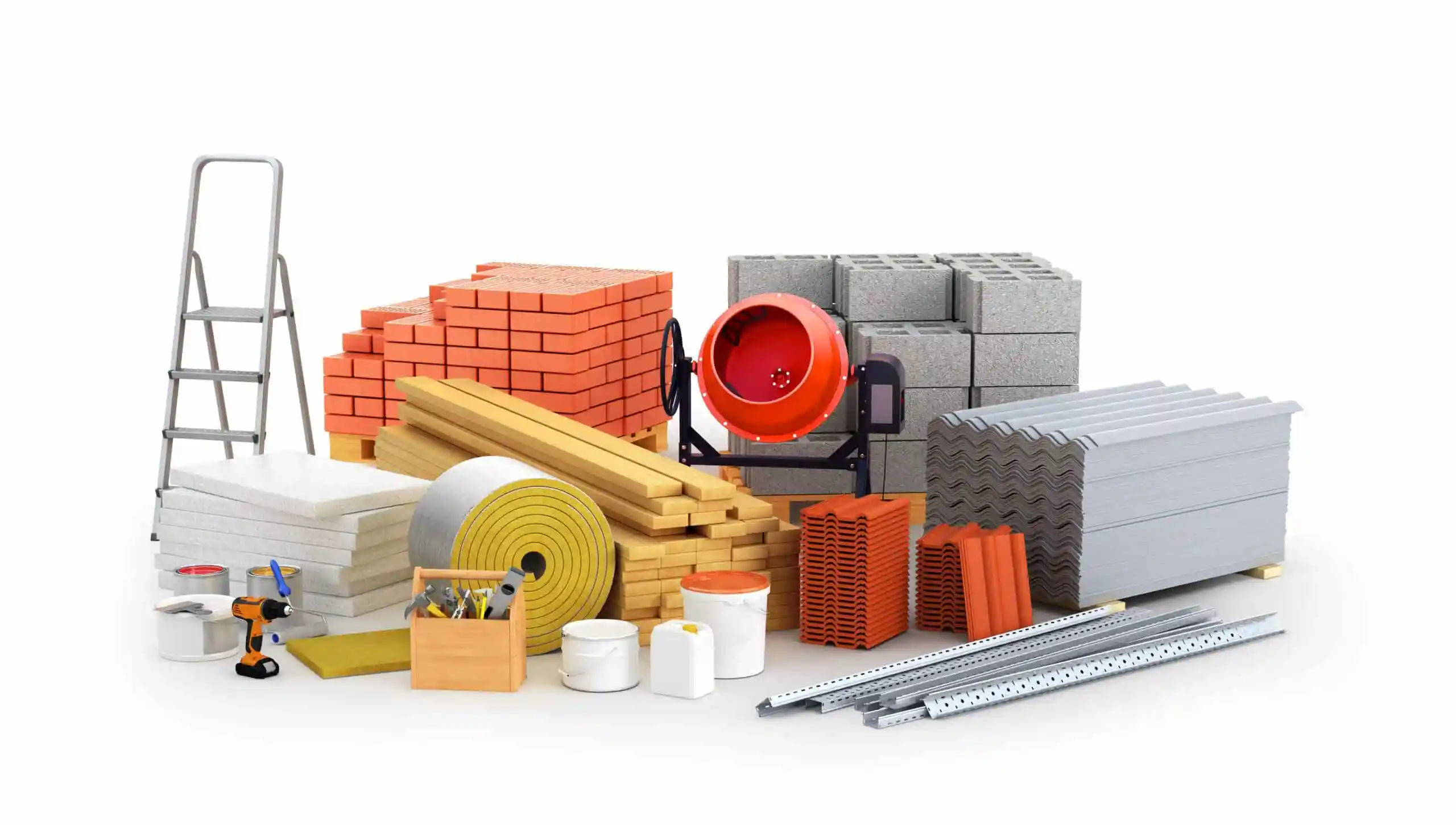Hey there, curious minds! Welcome to a journey into the incredible world of construction materials! These materials, like the LEGO blocks of the grown-up world, are the backbone of our buildings, from the tallest skyscrapers to the snug homes we call our own. Join us as we dive into the fascinating realm of wood, concrete, steel, glass, and more. We’ll learn about their strengths, weaknesses, and how they impact our planet. Let’s become construction material explorers together and build a better tomorrow, one brick at a time.
List of Materials in Construction
Building anything, whether it’s a majestic skyscraper or a cozy home, requires the right materials. These building blocks determine a structure’s safety, strength, and appearance. Let’s explore the diverse world of construction materials and their unique characteristics.
Heavyweights of Construction
- Concrete: This mixture of cement, sand, gravel, and water is the workhorse of construction. Known for its strength and durability, concrete is used for foundations, walls, and even bridges.
- Steel: This alloy of iron and carbon provides exceptional strength, making it ideal for skyscrapers, bridges, and large-scale structures. Steel beams, columns, and frameworks provide the backbone for countless buildings.
- Wood: A classic and versatile material, wood has been used in construction for centuries. Its availability, affordability, and surprising strength make it a favorite for framing, siding, roofing, and flooring.
Enhancing Style and Function
- Glass: This transparent wonder allows natural light to flood buildings, creating a sense of openness and reducing energy consumption. Glass is essential for windows, doors, and modern facades.
- Plastics: Lightweight, durable, and moisture-resistant, plastics play a vital role in construction. They are found in plumbing pipes, insulation, window frames, and various other applications.
Essential Components for Comfort and Safety
- Insulation: Fiberglass, foam, and even recycled denim can be used as insulation to regulate temperature and enhance energy efficiency in buildings.
- Roofing: Asphalt shingles, clay tiles, and metal sheets shield buildings from rain, snow, and wind, ensuring protection from the elements.
Choosing the Right Materials
Selecting construction materials is a critical process, much like a chef selecting ingredients. Factors to consider include:
- Strength & Durability: Can the material withstand the expected weight and environmental factors?
- Cost: Balancing budget constraints with material quality is crucial.
- Environmental Impact: Sustainable and eco-friendly materials are becoming increasingly important.
- Aesthetics: The visual appeal of materials contributes significantly to the overall design.
Understanding the world of construction materials allows us to appreciate the thought, engineering, and craftsmanship behind the structures we use every day. From foundations to rooftops, each material contributes to safety, functionality, and enduring beauty.
What are the Different Types of Construction Materials?
Building projects, from small residences to massive infrastructure, rely on diverse materials, each chosen for its unique properties and contributions to the structure’s integrity and function. Let’s categorize these materials based on their origins and typical applications:
Natural Building Blocks: From the Earth We Stand On
Nature provides remarkable building materials with distinct character and enduring appeal:
- Wood: This renewable resource offers strength, adaptability, and aesthetic warmth. Wood is widely used for framing, siding, roofing, and flooring.
- Stone: Known for its durability, fire resistance, and natural beauty, stone is often used for foundations, walls, and decorative elements.
- Brick: Durable, fire-resistant, and energy-efficient, brick remains a popular choice for walls, chimneys, and walkways.
- Clay: Malleability and fire resistance make clay suitable for producing bricks, tiles, and pipes.
Man-Made Materials: Engineered for Strength and Versatility
As technology progressed, we developed innovative materials to meet specific construction requirements:
- Concrete: This versatile material forms the foundations, walls, and slabs of countless structures due to its strength, durability, and adaptability.
- Steel: With exceptional strength, lightweight properties, and rust resistance, steel acts as the support beams and reinforcement in buildings, bridges, and various structures.
- Plastic: From plumbing pipes to windows, plastic’s durability, lightness, and affordability make it indispensable in construction.
- Glass: Beyond windows and doors, glass offers transparency, strength, and energy-saving potential, making it suitable for skylights and even entire walls.
The Power of Combination: Composite Materials
Combining the best properties of different materials leads to innovative solutions:
- Fiber-reinforced plastic (FRP): Adding fibers to plastic enhances its strength and lightweight properties, making it ideal for panels, roofing, and cladding.
- Insulated concrete forms (ICF): Combining concrete strength with insulation properties, ICFs create energy-efficient and structurally sound walls and foundations.
- Geotextiles: These permeable fabrics stabilize soil, aid in drainage, and enhance filtration in various construction applications.
Looking Ahead: The Future of Building Materials
The construction industry constantly evolves, introducing groundbreaking materials:
- Self-healing concrete: This futuristic material can repair its own cracks, potentially revolutionizing maintenance.
- Bio-based composites: Bamboo, hemp, and other natural materials offer sustainable alternatives for building components.
- Nanomaterials: Tiny particles with incredible properties, nanomaterials hold the potential to create stronger, lighter, and more durable construction materials.
Understanding construction materials allows us to appreciate the ingenuity behind our built environment. As technology advances, we can anticipate even more innovative and sustainable materials shaping the world around us.
How Do I Choose the Right Construction Materials for My Project?
Choosing the right construction materials is crucial for a successful project. Just as the wrong ingredients can ruin a recipe, improper material selection can lead to structural issues, cost overruns, and aesthetic disappointments. Here’s a guide to making informed decisions:
Understand Your Project Requirements
Before exploring material options, define your project’s specific needs.
- Purpose: What type of structure are you building? A residential home, a commercial building, or something else?
- Climate: Consider the environmental conditions of the location, such as temperature, humidity, and potential for extreme weather events.
- Budget: Establish a realistic budget to guide material choices without compromising quality.
- Lifespan: Determine the desired lifespan of the structure. A temporary structure has different material requirements than a permanent building.
- Sustainability: Prioritize eco-friendly options if environmental impact is a concern.
Explore Material Options
Familiarize yourself with the wide range of available materials:
Traditional Choices
- Wood: Renewable, strong, and aesthetically pleasing, wood remains a popular choice for various applications.
- Stone: Durable, fire-resistant, and visually appealing, stone offers timeless elegance.
- Brick: Cost-effective, low-maintenance, and fire-resistant, brick is a reliable option for walls, chimneys, and walkways.
- Clay: Versatile and durable, clay is used for bricks, tiles, and pipes.
Modern Advancements
- Concrete: Adaptable, strong, and durable, concrete is a fundamental material for modern construction.
- Steel: Known for its exceptional strength-to-weight ratio and fire resistance, steel is essential for large-scale and high-rise structures.
- Plastic: Lightweight, durable, and resistant to moisture, plastic is found in pipes, insulation, and various building components.
- Glass: From energy-efficient windows to stunning facades, glass offers transparency, strength, and design versatility.
Innovative Solutions
- Fiber-reinforced polymers (FRP): Combining strength and lightweight properties, FRPs are used for bridges, panels, and roofing.
- Insulated concrete forms (ICF): These forms provide insulation and structural integrity, making them ideal for energy-efficient buildings.
- Geotextiles: Essential for soil stabilization, drainage, and filtration, geotextiles are crucial for various construction projects.
Consider Emerging Materials
Stay updated on the latest advancements in construction materials:
- Self-healing concrete: This innovative material can repair its own cracks, potentially reducing maintenance costs and extending structural lifespan.
- Bio-based composites: Made from renewable resources like bamboo and hemp, these composites offer sustainable alternatives to traditional materials.
- Nanomaterials: These microscopic materials offer exceptional strength, durability, and other enhanced properties, paving the way for future innovations.
Embrace Sustainable Practices
Prioritize environmental responsibility by:
- Recycling and Reusing: Incorporate recycled materials and explore opportunities to reuse existing materials.
- Minimizing Waste: Plan carefully to optimize material usage and reduce waste generation.
- Considering Environmental Impact: Evaluate the environmental footprint of materials throughout their lifecycle, from sourcing to disposal.
Explore Advanced Construction Techniques
Embrace innovative construction methods that promote efficiency and sustainability:
- 3D Printing: This technology allows for precise and efficient construction using concrete and other materials.
- Modular Construction: Constructing buildings off-site in modules reduces waste, shortens construction timelines, and enhances quality control.
Key Takeaways
- Thoroughly understand your project’s requirements.
- Explore a wide range of traditional, modern, and emerging materials.
- Prioritize sustainable practices to minimize environmental impact.
- Consider advanced construction techniques for enhanced efficiency.
Remember, selecting the right construction materials is essential for a successful project. By carefully evaluating your needs, exploring options, and staying informed about advancements, you can make decisions that ensure the durability, functionality, and sustainability of your structure.
What are the Properties of Construction Materials?
Understanding the properties of construction materials is essential for selecting the best options for your project. Just as a chef considers the flavor and texture of ingredients, builders need to understand how materials will behave under various conditions. Here’s a closer look at key properties:
- Strength: This refers to a material’s ability to withstand external forces like compression (squeezing), tension (pulling), bending, or torsion (twisting) without breaking or deforming significantly. Strong materials are crucial for structural integrity.
- Density: Density is the mass of a material per unit volume. Denser materials tend to be heavier and provide better soundproofing and thermal insulation. However, they can also increase the overall weight of a structure, which is important to consider in the design.
- Durability: This property reflects a material’s ability to resist deterioration over time due to factors like weather exposure, abrasion, corrosion, or insect infestation. Durable materials extend the lifespan of structures and minimize maintenance needs.
- Thermal Conductivity: This measures how easily heat transfers through a material. Materials with low thermal conductivity, like insulation, help regulate indoor temperatures, reduce energy consumption for heating and cooling, and enhance comfort.
- Fire Resistance: Fire resistance is crucial for safety. It measures how well a material can withstand exposure to fire without igniting, burning, or losing its structural integrity.
Choosing the Right Materials: A Holistic Approach
Selecting construction materials involves evaluating various factors beyond basic properties:
- Aesthetics: The appearance of materials contributes significantly to a building’s design. Consider the color, texture, and overall visual appeal of materials.
- Cost: Balance your budget with desired material properties. Some materials offer excellent value for their cost, while others might require trade-offs.
- Availability: Ensure that chosen materials are readily available in your region or consider lead times for procurement.
- Environmental Impact: Opt for sustainable materials with minimal environmental footprints. Consider factors like embodied energy, recyclability, and responsible sourcing.
The Evolving Landscape of Construction Materials
The construction industry continues to innovate, introducing new materials and technologies:
- Traditional Materials: Wood, stone, brick, and clay remain relevant for their durability, aesthetic appeal, and sustainability.
- Alternative Materials: Recycled plastics, bamboo, and other eco-friendly options are gaining popularity as sustainable alternatives.
- Composite Materials: Combining different materials creates enhanced properties. Examples include reinforced concrete, fiber-reinforced polymers, and insulated concrete forms.
- Smart Materials: These innovative materials can adapt to environmental changes. Self-healing concrete and materials that respond to temperature or light are examples of future possibilities.
By carefully considering material properties, your project’s needs, and emerging trends, you can make informed decisions that result in safe, durable, and sustainable structures.
For all construction work, understanding the properties and selection criteria for materials is essential. This knowledge is crucial when working with structural elements like beams, architectural details like reveals, and essential systems like plumbing.
- 70+ Charming Flowers That Begin With C: A Visual Guide with Growing Tips - April 22, 2025
- How to Identify a Ground Wasp Nest: A Visual Guide - April 22, 2025
- Best Foldaway Poker Tables of 2024: Buyer’s Guide & Reviews - April 22, 2025










